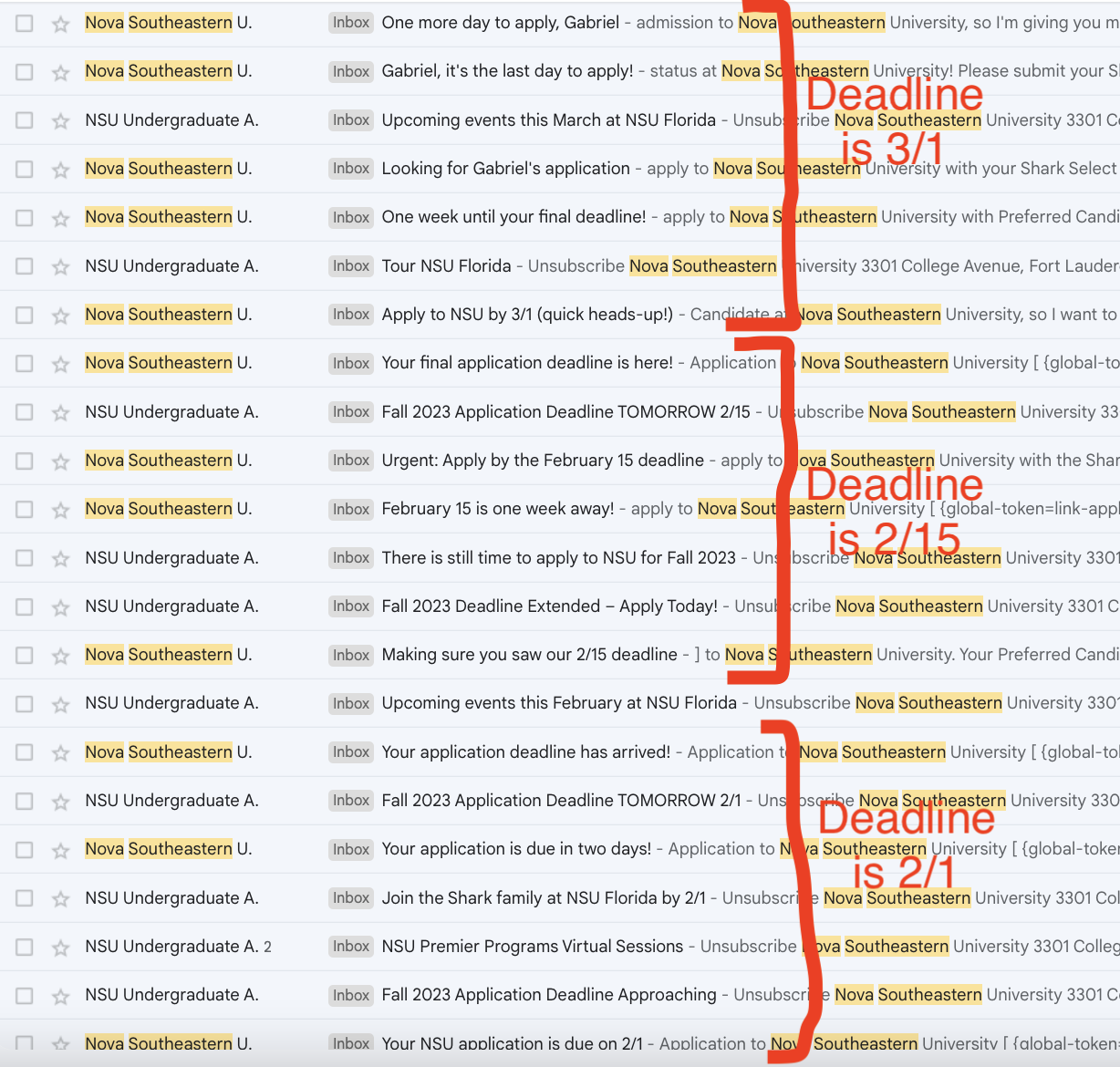Gabriel Thompson's Personal Blog
Recent posts Archive
6,498 Emails from 215 Colleges
Definitely one of the worst decisions I made during high school was signing up for the CollegeBoard's "Student Search Service". For those who aren't familiar, the service claims that it will help you "connect with colleges and scholarships" to fund your higher education.
This sounds appealing, but in reality it means that you'll receive thousands of obnoxious emails from colleges telling you to apply. Emails like this one:

Apparently Tulane decided that the only way to appeal to the modern generation was by sounding like a Twitch streamer. While sometimes these emails were good faith attempts to inform me about the college, the vast majority were as garbage as Tulane's.
I was curious about which colleges sent me the most emails and if there were any patterns in when they emailed me, so I downloaded my email history and wrote a Python program to find when every college emailed me. Here's a visualization I made of the result (right click and open in a new tab and zoom in to see in greater detail):

The first graph shows when I received emails from each of the 216 colleges. Each square represents how many times a given college emailed me a given week. Each college labeled on the y-axis has a unique ID number indicating where the college is on the chart, so that in this post I can refer to a college by it's name and number and it's easier to find. The second graph shows how many college emails I received in total per week.
The earliest email I received from any college was from Carnegie Mellon University (#1), although this was because I had indicated interest in CMU on Naviance, so it doesn't really count. The first promotional email I got from a college I didn't express interest in was from Tulane University (#2) on October 3rd, 2021. Even in August 2023, I still occasionally get emails from schools like UMass Dartmouth (#213).
It's interesting to see how some colleges changed the amount of emails they sent over time. For example, Case Western Reserve University (#11) sent me regular emails in increasing frequency until slowing down in August 2022, but still did continue to send me weekly-ish emails until their deadline in January 2023.
You can also see a peak in the lower graph around early August 2022 right after the Common App dropped and another two around the EA/ED and RD deadlines of November and January. At the same time as these peaks, you can also see vertical straight lines in the first graph, because a lot of colleges were emailing me in the same week.
The colleges that emailed me the most were:
Of the 6,498 emails I received, 1,845 contain the word "Gabriel" (my name) in the subject line. For some reason, colleges think that by putting the recipient's name in their email subject lines, the email will attract their attention? I don't really get this tactic myself, but a lot of colleges do it.
Siena College is the master of this, more than 80% of the emails they sent me contained my name in their subject. Some of their greatest hits include:



Anyways, I find it really uncomfortable to see colleges that I've never heard of pretending to be on a first-name basis with me. It's phony and weird.
Another tactic that some colleges used was constantly extending their deadline so that they could send me repeated emails claiming that their "deadline was approaching." Nova Southeastern did this several times:

You can visibly see Seton Hall University (#72) extending their deadline six times on the visualization earlier in the article. Their original RD deadline was February 1st, but they kept on extending it until as late as June 30th, so that they could have a reason keep sending me emails telling me to apply as late as then.
Another interesting pattern is that more selective, highly-ranked schools tended to email me less, and their emails tended to me less obnoxious. Ivy League colleges only emailed me 15 times on average, and none of these emails my first name in the subject line. MIT and Stanford didn't email me at all.
Anyways – I found this experiment mildly interesting and I hope this can serve as a warning to Juniors on why not to sign up for the Student Search Service.